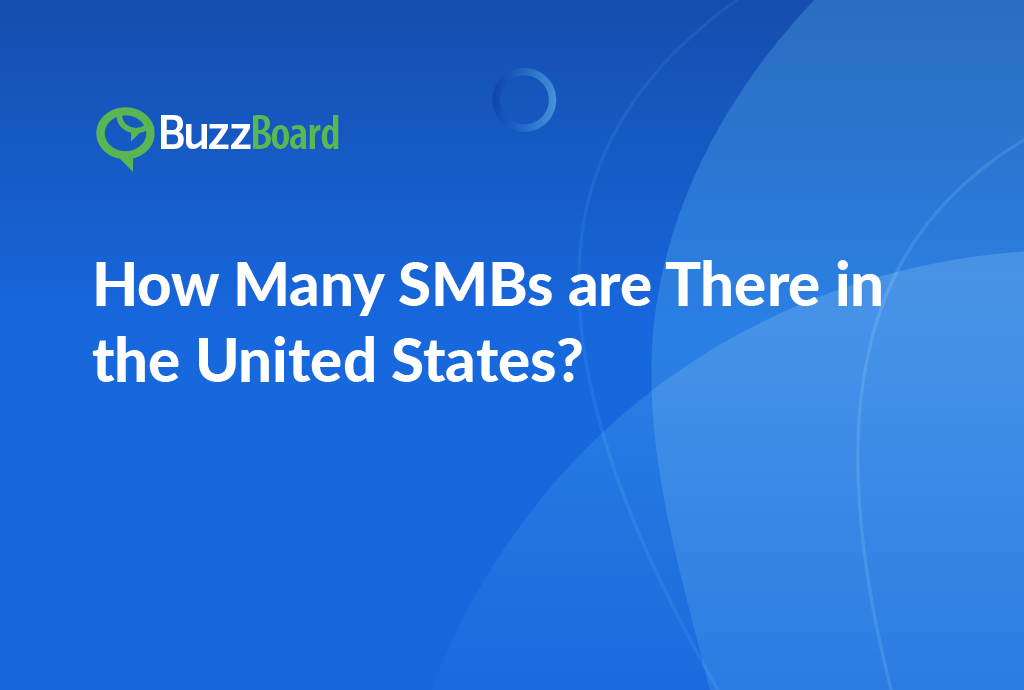How Many Small and Medium-Sized Businesses (SMBs) Are There in the United States?
According to the latest statistics, there are approximately 32.2 million small and medium-sized businesses (SMBs) in the United States, accounting for over 99.7% of all businesses in the country. These SMBs employ around 47.1 million people, which is roughly 43% of the total US workforce. The majority of SMBs are classified as small businesses, with fewer than 500 employees, while medium-sized businesses have between 500 and 1,000 employees. Understanding the number and scope of SMBs in the US is crucial for policymakers, entrepreneurs, and businesses looking to tap into this vast market.
An Overview Small Businesses in the United States
The small business landscape holds a significant position within the United States’ economy. A B2SMB (business-to-small-business) methodology can wield immense potential, given that small businesses greatly influence the country’s employment rates and gross domestic product.
As per the Small Business Administration (SBA), roughly 30.7 million small businesses exist within the U.S., comprising 99.9 percent of all businesses. These entities hold a crucial role in terms of employment. Roughly 47.3 percent of the private workforce is under payroll within these small businesses, translating to approximately 60.6 million individuals. This notable contribution emphasizes the critical role small businesses occupy in the U.S. job market, thus reinforcing the notion of selling to small businesses as a profitable venture.
The Small Business Administration (SBA) emphasizes the profound influence of small businesses on the country’s gross domestic product (GDP). According to a 2020 report, small businesses are responsible for approximately 44 percent of U.S. economic activity, underscoring their significant role in driving economic growth and development. This statistic highlights the immense potential that small businesses hold for digital marketing agencies seeking to expand their B2SMB (business-to-small-business) portfolio.
However, it is essential to acknowledge that the scope of small businesses is vast and diverse, encompassing a wide range of industries, sizes, and geographic locations. As a result, selling to this demographic requires a tailored, custom approach that takes into account their unique needs, limitations, and challenges. This may involve developing targeted marketing strategies, building strong relationships with small business owners and decision-makers, and providing personalized solutions that address their specific pain points and goals.
In addition, small businesses often face distinct challenges, such as limited resources, limited marketing budgets, and limited access to technology and expertise. As a result, digital marketing agencies must be prepared to adapt their strategies and tactics to meet the specific needs and constraints of small businesses. This may involve offering flexible pricing models, providing educational resources and training, and leveraging technology to streamline processes and improve efficiency.
Small businesses are not merely the backbone of the U.S. economy but also its lifeblood, providing millions of jobs and making substantial contributions to the GDP. Recognizing their impact and prevalence can help shape a more strategic B2SMB approach for digital marketing agencies seeking to engage with this key demographic. By understanding the unique needs and challenges of small businesses, digital marketing agencies can develop targeted marketing strategies, build strong relationships, and provide personalized solutions that help small businesses thrive and grow. Ultimately, this can lead to increased revenue, improved customer satisfaction, and a stronger, more resilient economy.
The Role of the Small Business Administration in Supporting SMBs
The Small Business Administration (SBA) plays a vital role in supporting Small to Medium Businesses (SMBs), particularly the segment served by digital marketing agencies. As a salesperson targeting the business-to-SMB market, it is essential to comprehend the SBA’s role for strategic and effective positioning of your services. Understanding the SBA’s mission, goals, and initiatives can help you tailor your sales approach, enhance your sales conversations, and ultimately achieve your sales objectives.
The SBA’s primary mission is to provide guidance, support, and resources to SMBs, thereby helping them navigate the complex process of initiating, sustaining, and expanding a business. This mission is crucial, as SMBs are the backbone of the economy, driving small business employment and contributing significantly to the Gross Domestic Product (GDP). In fact, according to the SBA, small businesses account for approximately 99.7% of all businesses in the United States, employ around 47.1% of the workforce, and generate around 43.5% of the country’s GDP.
As a salesperson navigating the SMB landscape, it is essential to recognize that selling to small businesses requires a nuanced approach. SMBs display unique business goals, challenges, and constraints that differ greatly from larger corporations. For instance, SMBs often face limited resources, tight budgets, and a lack of expertise in specific areas, making it essential to offer solutions that cater to their specific needs and objectives.
By understanding the SBA’s role and mission, you can gain invaluable insights into the SMB market. This knowledge can help you:
- Tailor your offerings: By understanding the SBA’s focus on supporting SMBs, you can tailor your services to meet the unique needs of small businesses, increasing the likelihood of a successful sale.
- Enhance sales conversations: With a deeper understanding of the SBA’s mission and goals, you can engage in more effective sales conversations, addressing the specific pain points and challenges faced by SMBs.
- Achieve sales objectives: By positioning your services as a solution that aligns with the SBA’s mission, you can increase your chances of closing deals and achieving your sales objectives.
Understanding the role of the SBA is crucial for salespeople targeting the SMB market. By grasping the SBA’s mission, goals, and initiatives, you can gain a deeper understanding of the SMB market, tailor your offerings, enhance your sales conversations, and ultimately achieve your sales objectives. As you navigate the SMB landscape, remember to continually seek further knowledge and adapt your approach to meet the evolving needs of small businesses. By doing so, you can build strong relationships with your SMB clients, drive growth, and contribute to the success of the small business community.
Exploring the B2SMB Market and its Significance to the US Economy
As sales leaders in digital marketing agencies, understanding the Business to Small Business (B2SMB) market is crucial to our success and the overall health of the U.S. economy. The influence of small businesses on the gross domestic product (GDP) is undeniable, making them a vital player in the national economy. According to the Small Business Administration, small business employment constitutes approximately half of the private workforce in the U.S., making them a significant contributor to the country’s economic growth.
To efficiently serve this sector, it is essential to recognize the unique challenges, necessities, and growth perspectives tied to small business operations. Unlike established corporations, small businesses have distinct traits and needs that require bespoke marketing solutions. They often lack the resources, infrastructure, and expertise to compete with larger companies, making it essential to develop tailored solutions that cater to their unique needs and financial constraints.
The B2SMB market presents a unique opportunity for digital marketing agencies to make a significant impact on the growth trajectory of small businesses. By providing apt products and services that enable these entities to grow, we can contribute directly to the overall economy. A robust B2SMB market indicates a prosperous and inclusive economy, where small businesses are empowered to thrive and create jobs, stimulate innovation, and drive economic growth.
As salespeople in marketing agencies, we are tasked with fostering growth within this segment. This requires a deep understanding of the B2SMB market, including the unique challenges and opportunities that small businesses face. By developing targeted marketing strategies and solutions that address the specific needs of small businesses, we can help them overcome the obstacles that hinder their growth and success.
In addition to the economic benefits, focusing on the B2SMB market also has social and community benefits. Small businesses are often the backbone of local communities, providing employment opportunities, supporting local suppliers, and contributing to the overall vitality of the community. By helping small businesses grow and thrive, we can also contribute to the well-being of local communities and the overall quality of life.
Understanding the B2SMB market is pivotal to the success of digital marketing agencies and the overall health of the U.S. economy. By recognizing the unique challenges and opportunities that small businesses face, we can develop targeted marketing solutions that enable them to grow and thrive. As salespeople in marketing agencies, we have a critical role to play in fostering growth within this segment, and by doing so, we can contribute to the overall prosperity and inclusivity of the economy.
Analysis of Small Business Employment and How Many People Work in SMBs in the US
The vitality of small businesses is a crucial component of the United States’ economic prosperity, making it essential for businesses that sell to these enterprises to have a deep understanding of small business employment. According to the Small Business Administration, small businesses are responsible for creating 64% of net new jobs, providing a significant opportunity for businesses-to-small-and-medium-sized-businesses (B2SMB) sales.
The contribution of small businesses to the Gross Domestic Product (GDP) is both notable and substantial. In fact, small businesses contribute approximately 44 cents for every dollar of GDP, which directly correlates to the number of people employed within these businesses across the United States. This highlights the significant impact that small businesses have on the economy, making them a vital component of the country’s economic landscape.
However, the number and influence of small businesses vary across industries and states, creating a complex landscape for B2SMB sales. For instance, some industries may have a higher concentration of small businesses, while others may have a greater number of large corporations. Similarly, certain states may have a higher proportion of small businesses compared to others. This complexity requires businesses that sell to small businesses to have a nuanced understanding of the SMB landscape, including the industries and regions in which they operate.
The fierce competition that small businesses face in today’s market requires innovative digital marketing strategies to cut through the clutter and reach their target audience. This is where digital marketing agencies can provide expertise, helping small businesses to develop effective online marketing campaigns that drive results. Astute digital marketers recognize the immense potential offered by small businesses, understanding the scope of people working in these businesses and their significance to the local, regional, and national economy.
By grasping the complexities of the SMB landscape, businesses that sell to small businesses can develop targeted marketing strategies that resonate with their target audience. This includes understanding the industries and regions in which small businesses operate, as well as the challenges and opportunities that they face. By doing so, businesses can develop effective marketing campaigns that drive results, helping small businesses to thrive and grow.
In addition, understanding the SMB landscape can also help businesses to identify new opportunities for growth and expansion. For instance, certain industries may be experiencing rapid growth, while others may be facing significant challenges. By identifying these trends and opportunities, businesses can develop targeted marketing strategies that capitalize on these trends and help small businesses to succeed.
In short, the robust vitality of small businesses is a crucial component of the United States’ economic prosperity, making it essential for businesses that sell to these enterprises to have a deep understanding of small business employment. By grasping the complexities of the SMB landscape, businesses can develop targeted marketing strategies that drive results, helping small businesses to thrive and grow.
Insight Into how SMBs Contribute to the US’ Gross Domestic Product
Understanding the significant contribution of small businesses to the United States’ gross domestic product (GDP) provides valuable insight into their profound impact on the nation’s economy. The Small Business Administration (SBA) emphasizes that these enterprises, often referred to as Small and Medium-sized Businesses (SMBs), not only stimulate economic growth but also play a vital role in technological innovation and job creation.
According to the SBA’s Office of Advocacy, small businesses account for a staggering 44 percent of U.S. economic activity. This statistic underscores the importance of SMBs as a driving force in the American economy, highlighting their substantial influence on the country’s economic landscape. Moreover, selling to small businesses (B2SMB) directly contributes to GDP, creating commercial opportunities and fostering economic growth by injecting capital into local communities and stimulating entrepreneurship.
Small businesses also play a crucial role in employment, with far-reaching implications for the overall job market. More than half of Americans either own or work for a small business, and these businesses create approximately two out of every three new jobs in the U.S. each year. This means that the economic success of SMBs has a direct impact on overall employment rates, making them a vital component of the nation’s labor market.
Furthermore, small businesses are often the backbone of local communities, providing essential services and products that cater to the unique needs of their customers. They are also more likely to invest in their communities, contributing to local economic development and revitalization efforts. In addition, SMBs are often more agile and adaptable than larger corporations, allowing them to quickly respond to changing market conditions and consumer preferences.
Despite the challenges they face, including limited resources, intense competition, and regulatory hurdles, SMBs demonstrate extraordinary resilience and adaptability. As salespeople at digital marketing agencies working with SMBs, it is essential to recognize their contribution to the economy and employment rates, as well as their unique needs and challenges. By understanding the importance of SMBs and the value they bring to the economy, we can better support their growth and development, ultimately driving economic prosperity and job creation.
Small businesses are a vital component of the U.S. economy, playing a significant role in economic growth, technological innovation, and job creation. As salespeople working with SMBs, it is crucial to recognize their importance and the challenges they face, and to develop strategies that support their success. By doing so, we can help foster a thriving small business ecosystem that drives economic prosperity and benefits the nation as a whole.
Conclusion
In conclusion, the United States is home to a vast and diverse array of small and medium-sized businesses (SMBs), playing a crucial role in the country’s economy. With over 32.2 million SMBs, they account for a staggering 99.7% of all businesses in the US, employing nearly 47.1 million people. These businesses are the backbone of the American economy, driving innovation, creating jobs, and contributing to local communities.
Understanding the scope and scale of SMBs in the US is essential for policymakers, entrepreneurs, and businesses looking to tap into this vast market. By recognizing the importance of SMBs, we can work towards creating a more supportive and conducive environment for them to thrive. This includes providing access to capital, resources, and training, as well as addressing the unique challenges they face, such as regulatory hurdles and competition from larger corporations.
As the US economy continues to evolve, it’s clear that SMBs will remain a vital component of its growth and success. By embracing and supporting these businesses, we can foster a more resilient and dynamic economy, driving prosperity and opportunity for generations to come.
Additional Resources
Understanding local, small and medium businesses.
Examples of small business categories.








